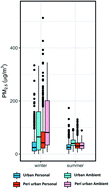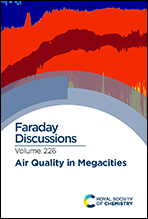Difference in ambient-personal exposure to PM2.5 and its inflammatory effect in local residents in urban and peri-urban Beijing, China: results of the AIRLESS project†
Abstract
Measurement of ambient fine particulate matter (PM2.5) is often used as a proxy of personal exposure in epidemiological studies. However, the difference between personal and ambient exposure, and whether it biases the estimates of health effects remain unknown. Based on an epidemiological study (AIRLESS) and simultaneously launched intensive monitoring campaigns (APHH), we quantified and compared the personal and ambient exposure to PM2.5 and the related health impact among residents in Beijing, China. In total, 123 urban and 128 peri-urban non-smoking participants were recruited from two well-established cohorts in Beijing. During winter 2016 and summer 2017, each participant was instructed to carry a validated personal air monitor (PAM) to measure PM2.5 concentration at high spatiotemporal resolution for seven consecutive days in each season. Multiple inflammatory biomarkers were measured, including exhaled NO, blood monocytes counts and C-reactive protein. Linear mixed-effect models were used for the associations between exposure and health outcomes with adjustment for confounders. The average level of daily personal exposure to PM2.5 was consistently lower than using corresponding ambient concentration, and the difference is greater during the winter. The personal to ambient (P/A) ratio of exposure to PM2.5 exhibited an exponentially declining trend, and showed larger variations when ambient PM2.5 levels < 25 μg m−3. Personal exposure to PM2.5 was significantly associated with the increase in respiratory and systemic inflammatory biomarkers; however, the associations were weaker or became insignificant when ambient concentrations were used. Exposure to ambient PM2.5 might not be a good proxy to estimate the health effect of exposure to personal PM2.5.

- This article is part of the themed collection: Air quality in megacities


 Please wait while we load your content...
Please wait while we load your content...